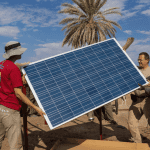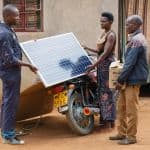The Overlapping Impacts of Off-Grid Solar: Four Ways Innovative Funding Can Enable the Sector to Advance Global Climate and Poverty Goals
Earlier this month, the Government of Kenya and the African Union co-hosted the very first Africa Climate Summit. They brought together 18 heads of African states as well as a range of other global leaders to discuss sustainable solutions to global climate challenges under the theme “Driving Green Growth and Climate Finance Solutions for Africa and the World.” The summit culminated in the Nairobi Declaration, a call to action proclaiming African states’ unified stance on climate action ahead of the 28th United Nations Climate Change Conference (COP28).
This was an important event that should substantially strengthen Africa’s voice in international climate negotiations and enable it to get more attention for its specific challenges and needs. Yet it also highlighted how much work remains to be done to clarify how the challenges of energy access and climate change are interlinked. For example, while the Nairobi Declaration emphasizes that 600 million Africans still lack access to any form of electricity, and about 970 million lack access to clean cooking, it fails to actually call for the delivery of universal access to energy as a key element of climate justice. This is a concerning omission in the statement, since universal energy access is an essential priority — not only because of the benefits electricity provides to underserved households, but because it’s a key element of building climate resilience and supporting green growth in vulnerable communities.
Despite this failure to embrace universal electrification, there is still clear reason for hope in Africa’s energy access sector. For 55% of the region’s unelectrified households, off-grid solar energy (rather than grid extension or mini-grids) is the quickest and cheapest solution to gain basic access to electricity — an approach that can both address the challenge of poverty by powering small enterprises, and also enable climate resilience and adaptation.
The off-grid solar industry has reached almost half a billion people with solar energy kits already, expanding energy access at the bottom of the pyramid through the PAYGo business model and reaching rural communities through last-mile distribution: people like Jamleck, a 63-year-old reverend and farmer who has seen his crops diversify and his cows produce more milk thanks to water available through a solar water pump; Hamza, a 4th grade student who can now study at home with a solar lamp instead of breathing in toxic fumes from a kerosene lamp; and Jamila, a midwife at a rural health clinic who no longer has to hold a lantern in her mouth when delivering babies at night thanks to a solar system.
As we’ll discuss below, these individual impacts are further amplified by the ways off-grid solar can advance global progress toward our shared climate and development goals.
The Role of the Off-Grid Solar Industry in Addressing Climate Change and Poverty
As a recent paper from GOGLA points out, this transformative technology can unlock opportunity and green growth. It has become a cornerstone of the global effort to achieve universal energy access, and the industry is committed to powering 1 billion lives by 2030. Without off-grid solutions, we will simply not reach the Sustainable Development Goals related to electricity access, climate or other key areas of global development.
The off-grid solar sector is large and diverse, with industry pioneers like Sun King illustrating how social enterprises can balance profitability, impact and scale, and around 150 innovative startup or seed phase companies hungry for investment to reach new frontiers. These innovators provide first-time energy access to those in need, and strengthen the electricity supply for weak grid customers. They also provide opportunities for these households to rise out of poverty by enhancing their connectivity, communication and financial inclusion — and also powering irrigation, cooling and agro-processing activities that can improve their crop yields and boost their incomes.
In light of these multifaceted impacts, how can we make sure the off-grid solar sector fulfils its potential to achieve its energy access and climate-related goals?
Four Ways Funding Can Advance Progress Toward Universal Energy Access
There’s one clear answer to that question, as more and better finance will remain essential to the industry’s efforts to scale. The off-grid solar sector has already shown that public funds can leverage private capital to unlock scale and innovation, as results-based finance programs have catalysed markets such as Kenya and Mozambique. But there is much more to do. By focusing on the four actions outlined below, we can rapidly and radically accelerate the pace of change.
- Use targeted public and philanthropic funding to crowd in investment by expanding and enhancing existing blended finance instruments and venture-building grants: As highlighted by Chris Clubb at Convergence in a NextBillion article earlier this year, blended finance mechanisms can enable small amounts of public and philanthropic funding to “become a catalyst for system-wide change.” Within the off-grid sector, we have many examples of successful collaborations featuring innovative blended finance models. For example, the Mirova SunFunder Gigaton Strategy provides blended debt financing for clean energy projects and small to medium-sized companies that are accelerating the transition to a low-carbon economy and improving energy access in Africa, the Asia Pacific and Latin America. And Triple Jump’s Energy Entrepreneurs Growth Fund provides tailored mezzanine, equity and debt investments combined with technical assistance to early and growth-stage companies in the access to energy ecosystem in sub-Saharan Africa.
- Unlock greater local currency financing and engage local financial institutions: This is vital for reducing the currency exchange risk that businesses in developing economies face when they borrow working capital from lenders in currencies such as U.S. dollars. Again, there are many promising examples of this approach in the off-grid sector. For instance, the African Development Bank and Green Climate Fund’s $800 million LEAF program promises to spur local currency investments from local financial institutions to scale up the activities of decentralized renewable energy companies. And the TCX – EU Market Creation Facility will offer discounted pricing in several target currencies, with the aim of increasing debt investment by not exposing borrowers to currency risk, and creating local-currency lending capacity when and where it’s most needed. However, we need to radically expand these efforts and decrease the cost of debt if we are to get closer to the sector’s access goals.
- Increase supply-side subsidies, consumer subsidies and other catalytic public finance mechanisms by governments and development institutions for consumers who can’t be reached with unsubsidized business models — or who are out of reach of current distribution areas in nascent markets: While there is exciting commercial potential — and emerging success stories — in the off-grid sector, to meet universal access goals, off-grid solar technologies need to penetrate the very hardest-to-reach markets. As of 2020, almost 300 million of the 733 million people without electricity were living in countries with only nascent off-grid solar markets, largely those with complex business environments. And the majority of solar kit customers live under the poverty line. Without subsidies, hundreds of millions will remain locked in energy poverty — but with them, progress can be rapid. This is exemplified by Nigeria’s Output-Based Fund for solar home systems, which has enabled 1.4 million solar home systems to be deployed from 2019 to 2022, close to four times the initial program target.
- Accelerate climate-aligned investment into the sector: The people who lack access to electricity are also the most vulnerable to climate change. And off-grid solar solutions are a powerful tool for climate adaptation and resilience, creating green jobs, enhancing food security, unlocking income and powering disaster response. This makes the off-grid industry a natural focus for climate-aligned financing, whether it comes from the public, private or development sectors. GOGLA applauds the Paris Agreement target of mobilising $100 billion per year for climate action in developing countries, and we strongly encourage governments and development banks to earmark a portion of this to energy access. We also encourage climate-aligned investors to leverage patient capital to help ensure that the world’s poorest people, who have done the least to contribute to the climate crisis, are not left without the tools to weather its impacts. Alongside these funding efforts, carbon finance markets can also actively support electricity access through the purchase of carbon credits generated by clean energy businesses and initiatives.
As the generational crises of climate change and global poverty continue to take a toll on communities around the world, the off-grid solar industry stands ready to innovate and collaborate in the search for lasting solutions. By properly understanding and monetising its impact, and recognising its huge climate investment potential, the global challenge of energy access can be turned into a valuable — and inevitable — global opportunity.
Laura Fortes is Senior Project Manager, Access to Finance, and Drew Corbyn is Head of Performance and Investment at GOGLA.
Photo courtesy of DIVatUSAID
- Categories
- Energy, Environment, Investing, Technology



